The Dream Team: Automated Document Generation & Salesforce
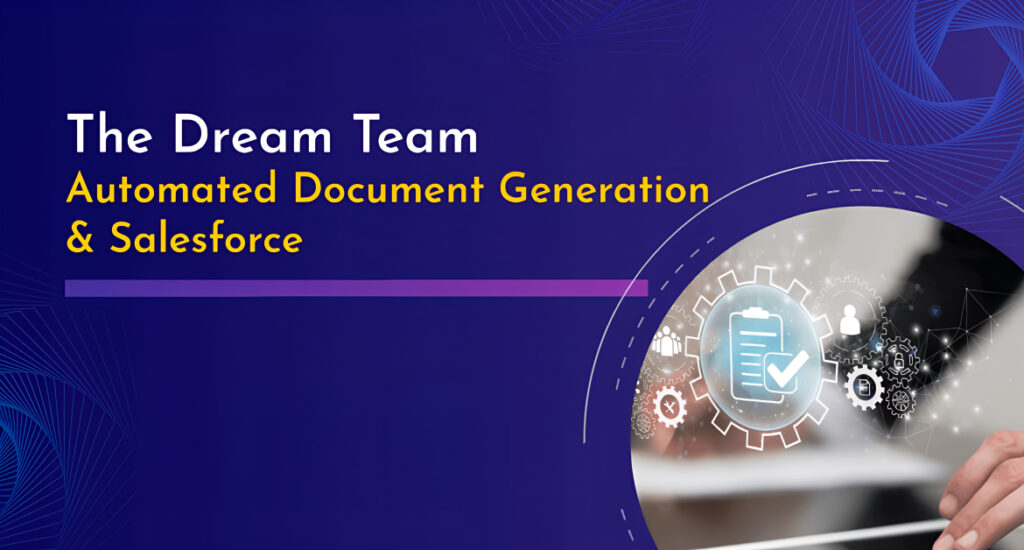
Let’s face it, managing docs manually is so last decade. In a world where time is money, juggling paperwork just doesn’t cut it anymore, especially in the realm of Salesforce document generation. Every minute spent drafting contracts, proposals, quotes, and invoices takes away valuable time. Imagine a scenario where team members are struggling to create error-free documents faster, going through long approval processes. Frustration builds, deadlines loom, and productivity gets stifled. With the rise of digital solutions, the push for intelligent document automation has never been stronger. Embracing automated document management isn’t just an upgrade, it’s a necessity. Why is Automated Document Generation Important in Salesforce? Salesforce is the ultimate CRM platform that every business needs to manage their customer relationships. Since most businesses are already using Salesforce and have all their data stored there, generating documents can get super tricky if you’re still relying on manual copy-pasting. When paired with powerful document generation tools, Salesforce transforms document automation and management into a seamless experience. This integration allows users to effortlessly create professional and personalized documents such as contracts, proposals, invoices, SOWs, and so on. Document Automation for Any Business Process Whether you need to generate sales proposals, legal contracts, invoices, customer service agreements, vendor agreements, partnership contracts, or offer letters an automated document generation solution serves all business functions. This versatility makes it an invaluable tool, applicable across various industries and departments. Accuracy and Consistency By pulling data automatically from the CRM, businesses can ensure accuracy and consistency while significantly reducing the time spent on manual document creation. Customization Automated document generation lets you easily customize documents for different clients by pulling in specific data points. This personal touch makes your documents feel more tailored and relevant, helping you build stronger relationships with your customers. Collaboration When documents are generated and stored in one central place, it’s much easier for teams to collaborate. Everyone can access what they need without hunting it down, leading to better communication and alignment among team members. Together, Salesforce integrated with advanced document generation tools form an ideal solution for organizations looking to enhance efficiency, improve collaboration, and elevate the overall customer experience. It’s all about making your processes easier, faster, and more effective, so your team can focus on what they do best. How XfilesPro DocuPrime Simplifies Doc Gen in Salesforce Let’s say you’re creating an invoice in Salesforce. Normally, you’d be switching between multiple apps to manage different document generation tasks, like editing, approving, getting eSign, and storing documents. But with XfilesPro, everything you need for your Document Lifecycle Management (DLM) is right there in one platform. Customizable Templates Instead of starting from scratch each time, DocuPrime allows you to use fully customizable templates. You can create an invoice format that reflects your brand, ensuring every document is consistent and professional. Want to adjust layout, and colors, or add personalized touches like the client’s name and account details? No problem, templates are flexible and designed to fit your needs, making the process super quick and hassle-free. Automated Data Capture All your latest pricing, discounts, and payment terms are pulled directly from your client’s Salesforce records. This means you won’t have to manually enter any details, DocuPrime ensures that every invoice reflects real-time data. Review & Approval Before an invoice goes out, it often needs a quick check. With DocuPrime, you can easily set up a review and approval workflow, ensuring that the invoice passes through the right hands for verification. Whether it’s checking for accuracy in pricing or confirming that payment terms are correct, the review process is streamlined and ensures no detail is overlooked. Plus, all this happens directly in Salesforce, so there’s no jumping between platforms. E-signature Once the invoice is reviewed, the next step is sealing the deal with an e-signature. DocuPrime integrates e-signature functionality directly into the process, making it easy for clients to sign off on invoices digitally. No more chasing down signatures or dealing with paper, it’s all done electronically, speeding up approvals and closing the loop faster. Document Generation After everything’s reviewed and signed, the invoice is ready for final generation. DocuPrime ensures the document is polished, complete, and ready to be sent. It pulls together all the personalized details and approved information into a final document that you can email to the client or use as required internally. No additional steps, just a smooth and efficient process from start to finish. Watch Our On-Demand Webinar: Generating Business Documents In Salesforce Once the documents are generated, it’s true that they take up valuable Salesforce file storage space. And as your business grows, so does the amount of data you’re managing, which can lead to storage limitations pretty quickly. But with XfilesPro, you don’t have to worry about exceeding Salesforce file storage limits. XfilesPro seamlessly moves all your documents to your preferred external cloud storage, Google Drive, SharePoint, AWS, or OneDrive. This not only frees up space within Salesforce but also keeps your documents easily accessible and organized in external storage without compromising security or performance. You’ll save on Salesforce storage costs, reduce clutter, and ensure that your document management process remains efficient as your business scales. It’s like having the best of both worlds: more space and smooth, efficient document management and streamlined Document Lifecycle Management(DLM). So, let’s leave behind the old-school paperwork and step into a future where managing documents is as simple as a click. Book a free demo with our experts today and experience the future of document management Poornima GConnecting businesses with top SaaS and CRM solutions through engaging content All Posts
Document IQ: Know What You Handle ‘Invoices’
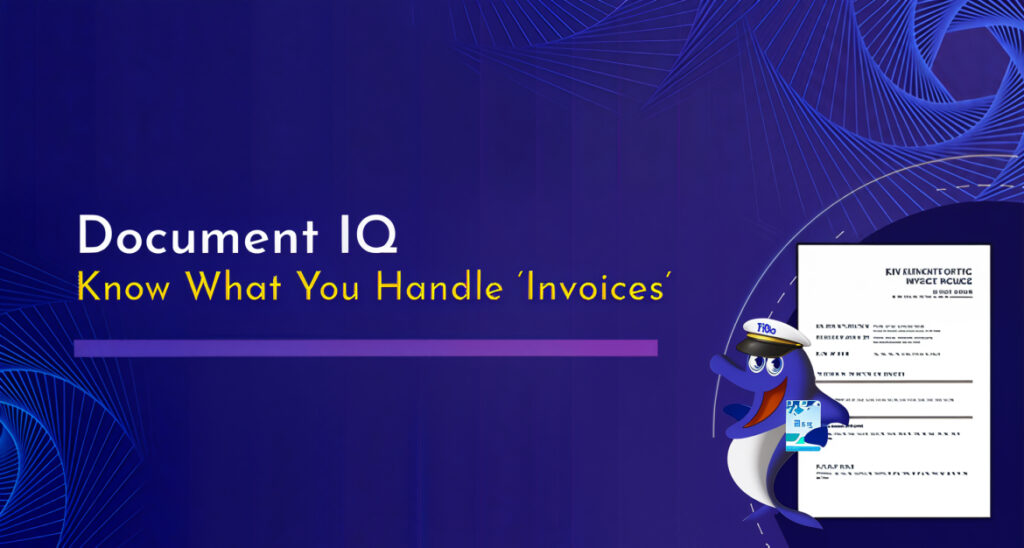
Welcome to Document IQ: Know What You Handle, your new go-to guide for mastering all those documents running your business in Salesforce. Think of it as the ultimate cheat sheet to work smarter, not harder. We’re about to dive into the key documents you’re handling daily – and trust me, by the end of this series, you’ll be a total document pro. Whether you’re sealing deals, tracking transactions, or planning projects, all these processes require documents to keep everything running smoothly. Let’s be real – managing these documents can feel like juggling a hundred tasks at once, right? Contracts, invoices, proposals, it’s a lot. But guess what? We’re here to make it easy. From contracts to invoices and everything in between, we’ll show you how to master the files that fuel your business without breaking a sweat. Why Documents Matter for Your Business Every organization, big or small, generates a diverse range of documents daily. From contracts and invoices to quotes, proposals, Statements of Work (SoW), Non-Disclosure forms (NDA), and more, these aren’t just routine paperwork – they’re the backbone that keeps businesses moving. Each document type has its unique role and is designed to meet different needs, showcasing how varied teams collaborate to keep things running effortlessly. Every piece of paper—or digital file—plays its part in the bigger picture, ensuring daily operations stay smooth and on point. Understanding the what, why, and how of these documents is crucial. We know how challenging it can be to read through lengthy content without losing interest. That’s why we’ve kept it simple and focused on just two key topics for you. No hustle, no bustle—taking things slow is always the best approach. What is An invoice? An invoice is a document issued by the seller to the buyer in relation to the sales transaction. It includes details of the products or services provided, their quantities, and price and serves as a formal request for payment. Why Is Invoice An Important Document? Invoices act as a detailed record of every transaction, capturing the what, when, and how much. They provide a clear audit trail for businesses and clients, ensuring transparency and maintaining strong customer relationships. By tracking invoices, businesses can keep a close eye on their cash flow-The net cash transferred in and out of a business. Knowing when payments are due and following up on outstanding balances helps maintain a healthy cash flow. This optimizes the use of company funds, and supports strategic financial planning, paving the way for future growth and opportunities. Detailed invoices are crucial for setting accurate budgets and predicting future financial outcomes. By analyzing historical data and market trends from past invoices, businesses can create more precise budgets and forecasts, facilitating better financial management. Maintaining accurate tax records is essential for tax reporting and compliance. invoices help calculate sales tax, VAT, and other taxes, ensuring precise tax filings. They support deductions and credits and are crucial for audits or reviews, preventing penalties, and ensuring adherence to tax regulations. Invoices serve as a formal agreement between seller and buyer. In case of disputes or legal matters, they provide proof of the transaction and terms agreed upon. Read More: Common use cases to Automate document generation in Salesforce Now that we understand the importance of these documents, What happens if they’re not spot-on or consistent? Here’s a rundown of the potential issues Missing or incorrect information on invoices, such as item descriptions, prices, payment terms, tax details, invoice numbers, contact information, or dates, can significantly impact businesses. Errors can lead to payment delays, customer disputes, and financial mismanagement. Incorrect invoices can complicate tax reporting. Mistakes in sales tax, VAT, or other tax-related details can result in compliance issues, penalties, or audits from tax authorities, impacting your business’s financial stability. Consistent mistakes or discrepancies in invoices can harm business reputation with clients. This can erode their trust, lead to disputes, and potentially cause them to take their business elsewhere. Invoices are often used as legal proof of transactions. If invoices are inaccurate, the possibility of encountering difficulties in legal disputes or compliance issues is always high, making it harder to defend your business or support your case in court. Even a simple mistake, such as mismatched currency, wrong dates, or a missing letter, which might seem minor, can ripple out and shake up the entire process. These small errors can cause confusion and miscalculations, resulting in miscommunication or misunderstandings. Inaccuracies, no matter how small, can disrupt workflow, strain customer relationships, and create additional administrative work, highlighting the importance of attention to detail in invoicing. But how can you ensure accuracy when, at the end of the day, we’re all just human? Maintaining perfect accuracy can seem impossible. That’s why we bring you XfilesPro DocuPrime. This user-friendly platform simplifies your document lifecycle management—from creating templates to securing e-signatures. With DocuPrime, Forget the stress of manual checks and the hassle of chasing down late or unpaid invoices. Try the app for free on AppExchange With DocuPrime, Salesforce invoice generation becomes straightforward. You can import and customize templates, add your company logo, and incorporate any other branding elements. The conditional formatting feature ensures that invoices automatically adapt to various scenarios, such as applying specific terms for different clients or adjusting pricing based on predefined criteria. All updates happen in real time which makes triggering any workflow easy. Once the template is set, data is automatically pulled from relevant objects and filled in. With DocuPrime, you can forget the stress of manual checks and the hassle of chasing down late or unpaid invoices. You no longer need to run around for review and approval processes or E-Signatures, everything is handled seamlessly under one platform. When the document is generated, you can download it in the format you need, PDF, Word, or PPTX. And setting it all up? Our technical team will take care of that with ease, so you can sit back and relax while they work their magic. What are you waiting for?
Sustainable Waste Management & Salesforce: XfilesPro’s Green Path to Paperless Documentation
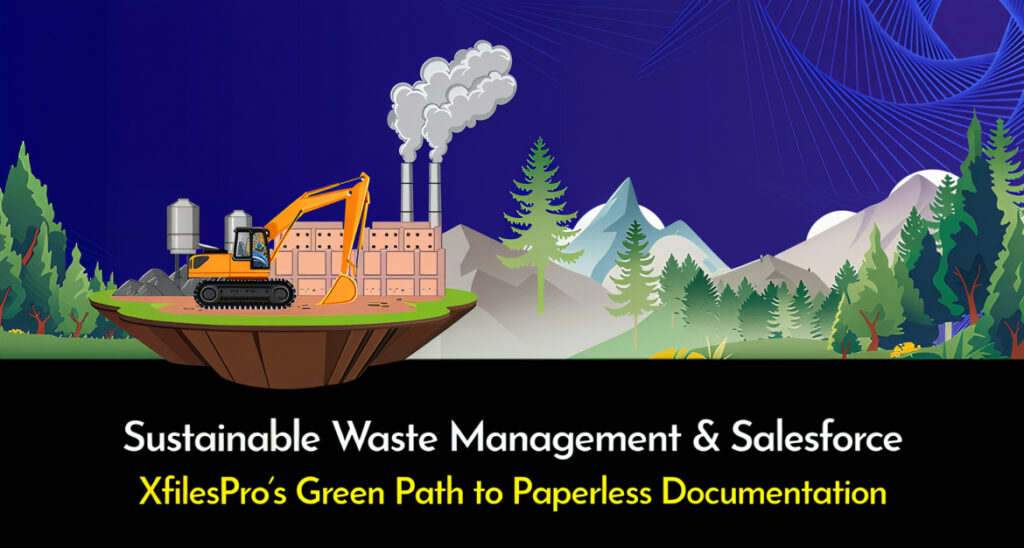
Sustainable waste management drives the shift from Make-Use-Dispose to Refuse, Reduce, Reuse, Repurpose, and Recycle—leading the charge for a greener tomorrow. In a world where the call for sustainability grows louder, waste management companies are at the forefront, implementing innovative solutions to reduce waste, enhance recycling efforts, and minimize their environmental impact. As we face irreversible changes in Earth’s systems, the growing threat of climate change can no longer be ignored. Environmental thresholds, such as rising global temperatures, melting polar ice, and deforestation, are being exceeded at alarming rates. This raises concerns about the potential domino effect where one environmental disaster triggers another putting global ecosystems and human societies at serious risk. Modern consumers are increasingly conscious of the environment and prefer to support businesses that prioritize sustainability. This trend goes beyond consumer preference; As responsible corporate citizens, they have a moral obligation to contribute to the well-being of society and the planet. Embracing sustainability demonstrates a company’s commitment to global efforts in combating climate change and preserving natural resources. As a result, more industries, regardless of their sector, are striving to maintain a green environment. Sustainability With Salesforce: Net Zero Cloud Businesses are becoming aware of the potential benefits and opportunities that come with adopting sustainable waste management practices. Companies are prioritizing sustainability to meet regulatory requirements, cut costs, and align with their environmental goals, they’re actively seeking partners who can support their efforts to reduce their carbon footprint and embrace greener practices. To further support sustainability, Salesforce Commerce Cloud provides the Net Zero Marketplace. With Net Zero Cloud Industries create ESG reports, buy carbon credits, and get detailed analytics to reach their ESG goals. 67% of the business leaders were concerned about climate change and its environmental impact on the ecosystem. The push for sustainable practices is intensifying from multiple sources: governments are enforcing stricter environmental regulations, consumers are demanding eco-friendly products, and investors are favoring companies with strong environmental, social, and governance (ESG) credentials. In response, industries are increasingly reaching out to sustainable waste management companies, guided by their ESG reports, to achieve their sustainability goals and integrate greener practices into their operations. Navigating The Complexities Of Waste Documentation Over 6000 companies globally had become certified B Corps as of August 2023. Most Sustainable industries will use Salesforce to get a comprehensive overview of their customers, analyze data, automate operations, and tailor solutions as per their requirements all to drive sustainable growth. While this integration is required for connecting with customers and meeting green goals, the process of onboarding the customers generally has a lot of documentation. To manage waste responsibly waste management industries capture a range of detailed information, which includes customer information, chemical composition, physical properties, regulatory data, shipping details, and general waste specifics. Let’s consider a sustainable company that needs to create documents based on the type of waste their customers are disposing of say hazardous and Non hazardous. The process of handling these two types of garbage is completely different. With different types of waste being generated and the need to track their compositions, the complexity can quickly become daunting, which means that the documentation for the waste is going to be entirely different. In most industries, the composition of waste isn’t static; it can change over time due to internal updates or shifts in production processes. In industries such as pharmaceuticals, chemical processing, and food and beverage production composition changes frequently. To manage these changes effectively, many sustainable companies require a Change in waste form whenever there’s even the slightest adjustment in waste composition. In addition to managing changes in waste composition, shipment is also one of the most frequently done tasks. Sometimes sustainable companies use a third third-party dealer to receive waste and deliver it to a facility. This means that they are generating documents such as Waste Transfer Note (WTN), Pre-Shipment Notification, Manifest, and more. Using traditional methods to generate these documents can become a stressful and time-consuming task, and a significant portion of employees\’ productive hours are consumed. climate crisis is not the only biggest challenge that companies face, manual document creation, is also prone to human errors and inaccuracies. A sustainable company that is dedicated to making a positive impact on the environment and facing the daunting task of generating and managing complex waste documentation can feel like a race against time in the fight against climate change. One of the most critical steps in generating a document is approval. With sustainable waste management companies, this step is even more crucial as they deal with different kinds of waste and hazardous waste of them all requires meticulous attention. For example, Land Disposal Restriction (LDR) forms which ensure that hazardous waste is treated to reduce its harmful effects before it can be disposed of in landfills or other land disposal facilities need approval from expertise. This helps ensure the waste is handled safely, complies with environmental rules, and avoids legal issues. While generating documents isn\’t already a battle against rising temperatures or melting ice caps, the manual approval process adds more time for the environmental crisis to escalate. The documents require review and approval for various reasons depending on the kind of waste that is disposed of because discarding different waste has different processes. Managing waste is like piecing together a complex puzzle, where every document plays a critical role in the big picture. Just like in a puzzle where one missing piece can disrupt the entire image, a small error or oversight in these documents can lead to significant problems, such as compliance issues, missed deadlines, or even environmental harm. Hazardous waste needs to be handled with stringent protocols to prevent environmental contamination, while non-hazardous waste has its own set of requirements. The Pre-Shipment Notification informs relevant parties about the details and timing of waste collection, preventing logistical issues. The Manifest provides a detailed record of the waste being transported, which is crucial for regulatory compliance and tracking. The Land Disposal Restriction (LDR) form ensures that hazardous
Document Lifecycle Management in Salesforce: Beyond Document Generation
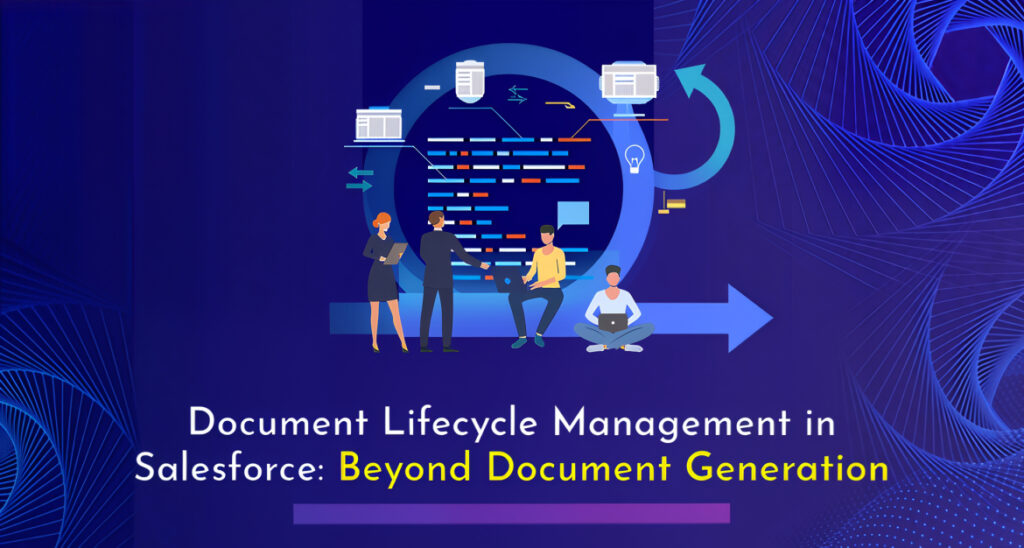
Imagine a world where document chaos is a thing of the past. With strategic Document Lifecycle Management (DLM) within Salesforce, you can turn this dream into reality. But what exactly is Document Lifecycle Management? How can it simplify the Salesforce document generation process to benefit your business? To learn more, please keep reading. What Is Document Lifecycle Management & How It Works? Before diving into Document Lifecycle Management, let’s break down what Document Lifecycle is. Simply put, it’s the complete journey of a document, from template setup to document generation, which includes review and approval workflows, obtaining e-signatures, collaboration, and storage. A Document Lifecycle Management tool transforms this process further by automating each stage, ensuring efficiency and accuracy throughout the process. Regardless of your business type or size, documents are crucial for daily operations and long-term success. A highly automated and simplified process is essential to streamline document generation and management process using a powerful document management app built to work with Salesforce. Document Management process basically consists of four key stages; Template Creation & Management The most common documents generated in Salesforce are Proposals, Quotes, Contracts, Invoices, and Statement of Work (SOW) etc. These documents are used to outline potential projects to clients (Proposals), estimate prices (Quotes), formalize agreements (Contracts) and ensure clear, agreed-upon project expectations (Statements of Work and Invoices), guiding the entire process from initial proposal to closing the deal. Templates can either be standardized or customized based on requirements. Once the appropriate template is selected or created, data is pulled from the relevant objects and automatically filled in, ensuring accuracy. Once created, templates can also be reused to save time. Review & Approval Without a review process, the likelihood of processing inefficient documents is high, which could result in miscommunication. It verifies that the reviewed documents are kept spot-on, meet all the standards & policies, and get the green light before they’re finalized. E-Signature For the final use of the document, an authorized signature is essential. This ensures that the document has not been tampered with since approval and confirms that all parties agree to the terms and conditions outlined in the document. An E-Sign simplifies this process by making everything digital, allowing signatures from anywhere, at any time. Document Generation The final step in document lifecycle management is document generation. The reviewed document is merged with the selected template to generate the document’s final version. The generated document is consistent, error-free, and ready for distribution or further processing. You can either choose to store these generated documents within Salesforce or move them to external cloud storage by leveraging the capabilities of XfilesPro. Visit our website to find out how. Common Challenges in Document Generation As businesses embrace digital transformation, they’re on the lookout for automated solutions to streamline their operations. Since document generation is a core part of most business processes, the manual creation of documents comes with its challenges. This process can be prone to human error, leading to inconsistencies between different versions. Some challenges are; Programming Requirement Integrating a third-party document generation tool with Salesforce can be tricky, often needing a lot of coding for template editing, which can make it less user-friendly. Risk of Errors Manual document creation is error-prone due to manual data entry, and copying from various sources. Searching for information can be a tedious task and often results in typos and formatting inconsistencies. Difficulty In Scalability As business expands, the process of manually creating documents becomes more cumbersome and difficult to manage, making it difficult to scale operations efficiently. Individually creating documents daily not only consumes significant resources thereby hindering productivity. Document Version Control Tracking document versions and ensuring the latest is used can be challenging, especially when done manually. After each review and subsequent changes are made, it can be frustrating to verify that all teammates are working on the same document. Approval Delays Since most approvals occur via email, there is a high chance that emails may get lost or individuals might overlook them. This can lead to missed approvals and subsequent delays. Benefits of a Document Lifecycle Management Tool A strategic Document Lifecycle Management (DLM) system can transform businesses by automating the entire document management process—from creation and approval to e-signatures and storage. This seamless integration streamlines operations, reducing manual efforts and errors. Key benefits of DLM includes; Time-Saving In the hustle and bustle of modern business, you really can’t underestimate the importance of timing. By leveraging automatic document generation tools, organizations can quickly produce documents, significantly reducing the time required compared to manual processes. For example, the sales team uses automated quote templates to establish base prices for services. This ensures consistency across all quotes and allows for easy reuse. As a result, manual document creation time is cut down, enabling the sales team to focus more on what matters most: selling. Reduced Risk of Errors As data is automatically pulled from relevant objects, the risk of errors is significantly reduced. Additionally, incorporating multiple checks from different individuals helps catch mistakes that a single creator might overlook. For instance, when the sales team reuses a template, a thorough review process ensures that all details are current and correct. Any necessary changes are made during this stage, further minimizing the risk of errors. Enhanced Collaboration Since approval occurs on reviewed documents, it’s crucial to ensure that approval is done on the latest version. Real-time editing and centralized access help make sure everyone is working with the most up-to-date document, so everyone sees the latest version. This approach boosts collaboration by ensuring that all team members are on the same page, reducing confusion, and streamlining communication, which leads to more effective and coordinated teamwork. Streamlined Document Generation Process With automation tools, organizations can simplify each step, from initial template creation to final e-signature. This approach reduces errors, speeds up workflows, and maintains consistency across all documents. Automation handles routine tasks, freeing up valuable time for teams to focus on more strategic activities. In summary, using a Document Lifecycle Management tool
Why Document Management in Salesforce is Important? 5 Reasons
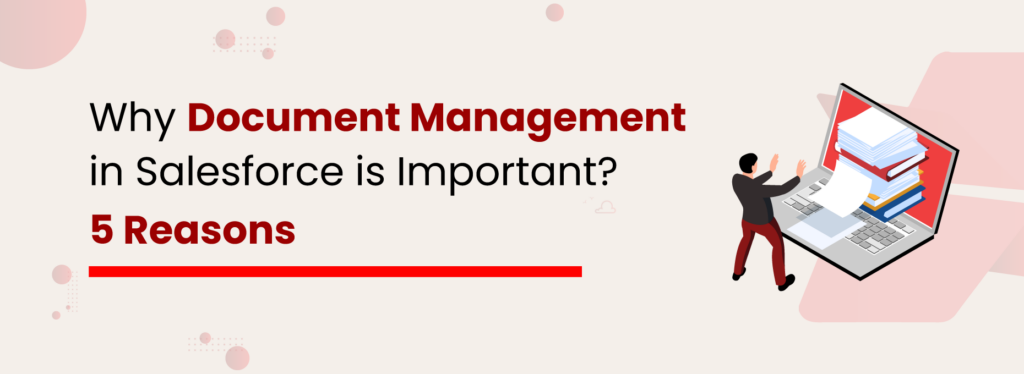
Data and documents are at the center of every business process in Salesforce. However, the profuseness of documents always creates challenges for users as an effective Salesforce Document Management System is not everyone’s forte. Having said that, your challenges in managing Salesforce documents shouldn’t impede the growth of your business. As a Nitro study reports, 50% of employees spend productive time creating and managing documents, which shows the minimal time they have left to focus on their high-value work. The only solution for this challenge is embracing a robust document management solution for Salesforce! Before learning how can such a solution help you, let’s take a look at document management in Salesforce. What is Salesforce Document Management System? Document management in Salesforce refers to how a company handles its day-to-day documents within the CRM platform. This includes creating, organizing, storing, accessing, and managing files such as PDFs, Word documents, JPGs, and PPTs. Documents come through many means, such as email attachments, manual uploads, or 3rd-party apps. Whether the business falls in the range of a small, medium, or large scale, users are required to manage a plethora of documents. Document Management Features in Salesforce Salesforce is now more than just a CRM, it’s a full-blown ecosystem that powers businesses with automation, AI, and analytics. Let’s explore Salesforce document management capabilities: XfilesPro The One-Stop Solution for Advanced Salesforce Document Management Download the Free Datasheet! Attachments Attachments provide a basic way to add files directly to Salesforce records. Users can upload supporting documents such as receipts, invoices, or contracts. Key Features: Quick and easy way to attach files to records Allows users to reference documents within customer or project records Limitations: There is no version control, making it difficult to track file updates Limited metadata support, reducing searchability Documents Tab The Documents Tab allows businesses to store and organize files within individual Salesforce records, such as accounts, opportunities, and cases. This feature is particularly useful for attaching contracts, proposals, or invoices to specific business transactions. Key Features: Simple document storage within Salesforce records Supports basic file uploads and downloads Useful for record-specific file management Limitations: Cannot be used for global file sharing across the organization Lacks advanced document lifecycle management tools Salesforce Knowledge For businesses managing articles, FAQs, and documentation in a structured format, Salesforce Knowledge could be the best solution. It serves as a self-service knowledge base where employees and customers can easily find solutions without repetitive inquiries. Articles can be linked to cases and records, making it highly beneficial for customer support teams. Key Features: A centralized knowledge base for quick access to information Supports article categorization and search functionality Can be linked to customer support cases for improved service efficiency Limitations: Primarily designed for knowledge management, not general file storage Limited customization for broader document workflows Files Home Files Home serves as a centralized hub where users can store, manage, and collaborate on documents within Salesforce. It provides a unified view of all files associated with records, making organization and retrieval seamless. Users can upload various file types, including documents, spreadsheets, presentations, and images. Key Features: Centralized file storage with easy access to related records Supports multiple file formats Integration with Chatter and Communities for enhanced collaboration Limitations: Limited metadata support for files Lacks advanced document management capabilities Salesforce CRM Content Salesforce CRM Content is a dedicated content management system designed for organizing, sharing, and tracking documents across an organization. It includes version control, document categorization, and advanced search functionality, ensuring you can efficiently manage files. Additionally, it enables access permissions and workflow automation for document approvals. Key Features: Advanced file organization with version control Granular access permissions for document security Approval workflows for compliance and document governance Limitations: Requires a separate license and additional configuration Not cost efficient Not the best choice for teams needing lightweight file management Why You Need A Salesforce Document Management Solution It’s widely held that businesses managing millions of documents can benefit from document management solutions. This belief is true considering the advantages that the implementation of a document management system (DMS) in Salesforce can drive for your business. XfilesPro Choosing The Right Document Management Application For Salesforce Get the Free Datasheet! While Salesforce offers several capabilities for document management, many organizations seek the support of a 3rd party document management solution that covers their end-to-end requirements. Five reasons why a Salesforce document management system is important: Overcoming Salesforce Storage Limit Salesforce’s limited file storage makes it challenging to manage a high volume of documents within the CRM. However, a smart document management system can help by automatically offloading large volumes of documents from your Org, freeing up space. This not only optimizes storage but also enhances platform performance, and reduces load time enabling efficient document management in Salesforce. Huge Cost Saving Once you exceed the Salesforce file storage limit, you need to upgrade the storage space for a certain cost. What if that space also gets exhausted? You will upgrade it again. But how long can this strategy last as a sustainable approach, considering the money loss associated with it? With an efficient Salesforce document management solution, you can address this concern by eliminating the need for storage upgrades. Documents are moved out of Salesforce, and the file storage space is always freed up. Enhanced Business Efficiency Adopting a Salesforce document management system boosts your productivity by reducing the time and effort needed to build, manage, and store documents. For instance, bulk contract creation, approval, and storage on a different platform can be automated in Salesforce. The more you minimize document management time, the more time workers have to focus on strategic tasks, speeding up decision-making and boosting overall efficiency. Seamless Scaling As your business grows, so does the number of documents you need to manage. With a Salesforce document management system, whether you’re scaling in terms of geographic regions, departments, or product lines, the system grows with you. It gives you the capacity to manage an increasing amount of content
A Decade of XfilesPro: Pioneering Document Management in Salesforce for 10 Remarkable Years!
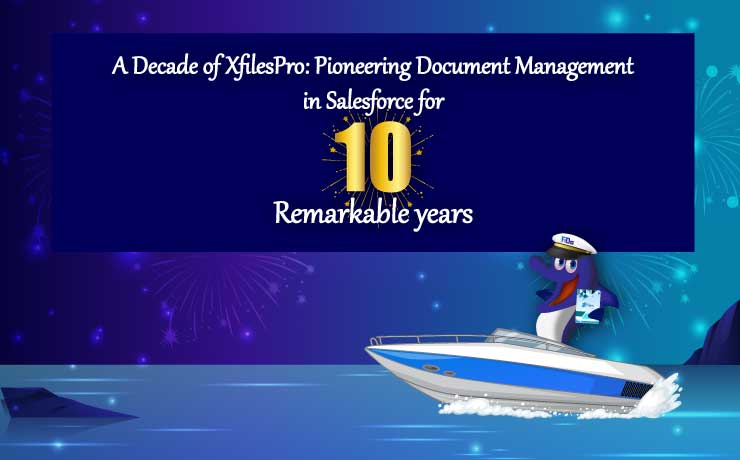
Phew…Just like that, our first baby turns ten! Who knew that time could fly this fast? It seems like just yesterday we introduced our most intelligent and adorable kid to the Salesforce world. Today, he has grown to be the one-stop solution for Salesforce users around the globe for their document management needs. If you’re wondering who we are talking about – it’s our Gen Z kid XfilesPro. From the launch in 2012 as EXTFM to a big brand name XfilesPro provides solutions for document management challenges in Salesforce, the journey of our flagship application has been incredible and upwards. Today, it’s delivering two on-demand solutions for Salesforce users — file management and document generation apps with advancements that no one else provides. We will tell you more about XfilesPro’s journey. A decade ago, XfilesPro stepped into the booming Salesforce ecosystem as an app supporting AWS S3. Later, we advanced the solution by extending its wings to SharePoint, Google Drive, OneDrive, and On-premises platforms. So, XfilesPro can now help #AwesomeAdmins get rid of their ever-complicated task – document management in Salesforce. The admins can move their growing volume of files from Salesforce to their preferred external storage in order to free up storage space and achieve peace of mind. This is the magic that XfilesPro’s file management application does. The best part is that it’s not only the external integration or file migration functionality that the next-gen application provides. There are a lot of other capabilities that make XfilesPro a complete document management system and a cut above the rest. Enhanced File Collaboration: XfilesPro’s Bi-sync functionality plays a big role here. It syncs Salesforce records with respective files in the external storage so that the modifications on files can be reflected in both platforms. This streamlines the file collaboration as internal employees can work on files within Salesforce while external users modify the files in the external storage and can have the real-time changes reflected. A Centralized File Management Process: XfilesPro nurtures a centralized file management system where different external systems can be integrated with Salesforce through a single-point file management system. Be it a 3rd party or an AppExchange app you’re integrating with Salesforce, your external storage will be the centralized file location where the user can access and edit files. Customized Folder Structure Creation: Since Salesforce poses limitations in creating folder formats, XfilesPro empowers them to build their preferred structure in the external storage so that the files can be arranged in a way that makes sense to their business. Here, XfilesPro provides two options, template folder structure and custom folder structure. The former is an easy-to-understand folder format that comes by default with XfilesPro, where users can easily access files. And, the latter helps the users to customize their folder structure as per the business requirements. Massive File Migration in One-Go: If the customer has already accumulated certain volumes of files in their Salesforce file storage, XfilesPro can easily push them to the external repository in one shot by maintaining the hierarchy between files. Enhanced File Security: XfilesPro understands the users’ concerns regarding the security aspect of storing Salesforce files in an external storage location. Here’s where XfilesPro’s Access Control functionality comes into play, ensuring that authorized users gain the ultimate control to decide who can view and access their documents. Significant Cost Savings: The cost of additional storage purchases from Salesforce may not sound cost-effective for your business. Since XfilesPro optimizes the storage space and eliminates the need for storage upgrades, customers can save exorbitant money. Also, Read: XfilesPro 9-Years Of Journey – Top Highlights Now, let’s talk about the recent and biggest addition we have made to the XfilesPro family — XfilesPro DocuPrime. It’s the modern auto document generation app for Salesforce that automates the generation of documents of any type, size, and volume 100% natively within the CRM platforms. So, the users can eliminate the manual efforts of creating a document as the application automatically fetches data from multiple Salesforce objects and fills out the respective spaces to generate documents. With added functionalities like support for popular 3rd party eSigns, customized template creation, and template import, XfilesPro DocuPrime reinvents the never-ending, tedious document generation process of Salesforce users. With two superior applications, XfilesPro provides a holistic platform for Salesforce users to generate and manage documents within the CRM with zero human involvement and in a way like never before. Through this elevated document management experience, the users can drive their attention back to strategic business goals without being worried about the growing volume of documents. This is what makes XfilesPro a fully-fledged document management system for Salesforce. So, where does XfilesPro stand today? With the ground-breaking addition of DocuPrime to the family, we started experiencing the tremendous growth of XfilesPro in the world of Salesforce. With a strong background of 500+ customers from around the world with 500k+ user licenses that have been granted to be renowned as the most trusted and recommended document management suite for Salesforce, XfilesPro has come a long way in a span of 10 years. And, with the announcement of Captain FiDo in 2022 as the official mascot, the brand value of XfilesPro scaled to the next level in a way like never before. In addition, it takes immense pride to bask in the glory of five stars in AppExchange for the app. Altogether, we should say, that it’s been a decade of unstoppable progress in XfilesPro’s history. But, XfilesPro’s innovation doesn’t stop here. The application will go above and beyond every year to accomplish the growing and evolving requirements of the customers by continuing to push the envelope. Because XfilesPro is 10 years stronger and prouder now! Meanwhile, look into the Top 3 Moments During XfilesPro’s 9th Anniversary Event Finally, big cheers to XfilesPro’s customers, leadership team, employees, and partners for their continued striving and efforts to meet excellence. This note would never be complete without acknowledging their significant contributions. So, repeat after us, a decade of

